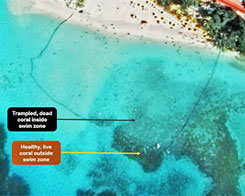‘We ask for advice and then ignore it. That needs to stop’

Google Earth (Digital Globe) Satellite Imagery shows that corals outside the Managaha Swim Zone are relatively healthy compared to within the swim zone ropes, where they are grey and dead. (Contributed Photo)
Afraid of catastrophic flooding? Let’s keep our corals healthy.
Corals provide a buffer against waves, storms, and floods, helping prevent erosion, property damage, and deaths. Saipan’s coral reef systems, particularly the barrier and fringing reefs along the west side of the island, are the key to preventing catastrophic flooding under storm scenarios.
“This means keeping our coral as healthy as possible,” said Robbie Greene, coastal management specialist with the National Oceanic and Atmospheric Administration.
In many cases, even after prolonged exposure to thermal stress, corals can still recover from bleaching. However, they can only do this if they are healthy and with the community’s help. That can be done now with two actions: reducing the amount of pollutant loads and sediment that get dumped into the reefs during heavy rains and putting an end to tourist behaviors that damage corals.
Preventing sediments
“Whenever the stormwater drainages in Garapan are released into the [Saipan] Lagoon, we are pouring gasoline on the fire,” Greene said.
“The sediment plumes we see reaching far out into the lagoon, from San Roque all the way down to Sugar Dock after a heavy rainfall, create stress on the reef, and the nutrient loading that accompanies some of that runoff can promote harmful algal growth on top of it all,” he added.
About 10 years ago, the CNMI government contracted out the development of a Saipan Lagoon Aquatic Ecosystem Restoration Plan, and the No. 1 recommendation to improve lagoon and reef health was the creation of large-scale stormwater ponding basins at key points in the Garapan/Tapochau Watershed.
The Saipan Lagoon Aquatic Ecosystem Restoration Plan, released in September 2013, considered the construction of the basins as the most cost-effective and efficient management measure to efficiently collect the majority of sediment, nutrient, and contaminant laden runoff that would otherwise become directly washed into the lagoon.
The preferred alternative in the SLAERP was to use the area where the old cockfighting arena was on Middle Road as a massive retention and filtration area, diverting significant accumulations of stormwater and sediment into the basin.
“The space is now a “business hotel” and parking lot. We ask for advice and then ignore it, and that needs to stop,” Greene said.
Changing tourist behaviors
The direct damage that tourists are doing to the CNMI reefs is astounding.
A look at a Google Earth image of the Managaha Swim Zone reveals an area that is grey and dead in contrast to corals looking relatively healthy just inches outside the roped swim zone.
“All of this means that folks in decision-making positions will need to make some unpopular decisions. We need a shift in perspective,” Greene suggests.
Greene further explained that, while in the near-term, tourists want to touch corals and carve their names underwater on the Grotto substrate, in the long-term though, they will not come to the islands if there is no living coral left.
Also, in the near-term, investors want to invest directly along the shoreline, and in areas where supporting infrastructure is threatened by sea level rise and future storms.
“It’s not popular to dissuade investment,” Greene said, “but ultimately we compromise our economic future and the Commonwealth’s future when we knowingly grow the physical and economic landscape directly into harm’s path.”
In the CNMI, the Bureau of Environmental and Coastal Quality’s Division of Coastal Resource Management implements the Coral Reef Initiative, a cross-agency initiative to protect and preserve the islands’ coral reefs, as well as the resources associated with those habitats.























